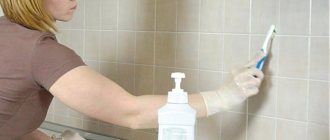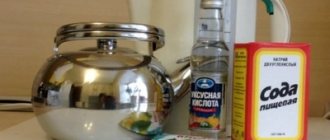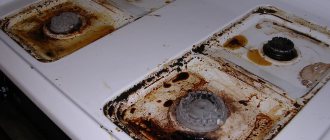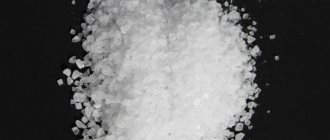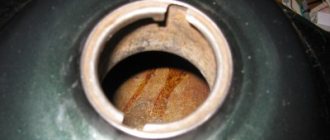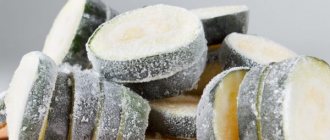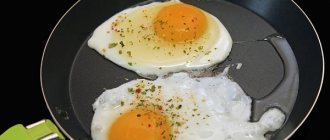With constant use, the kettle gets dirty and even with regular washing it loses its shine and looks worse. If it is left on the stove while cooking other dishes, oil and grease stains will form on the outside due to splashes. Experienced housewives advise using ordinary folk remedies for washing, rather than expensive store-bought ones. So, a stainless steel kettle can be washed with vinegar, soda, citric acid or activated carbon. Among the non-standard methods, one can highlight the use of PVA glue and laundry soap, but first things first.
Dry mustard
Our grandmothers also knew how to clean grease from a kettle using mustard. Prepare the mixture by mixing a teaspoon each of dry mustard and granulated sugar. Add a little water to form something like a paste. Rub the sides of the dish and leave until dry. Then rub the equipment until shiny and rinse under running water. The same tool will help those who do not know how to clean carbon deposits from a kettle.
Basic folk methods of cleaning at home
Products are washed fastest if you remove dirt from them immediately. Therefore, if the kettle has not been washed for a long time, you will have to work hard. In any case, you need to prepare:
- spacious container;
- sponges with soft and hard surfaces;
- a small brush for cleaning hard-to-reach places, an old toothbrush will do;
- clean cloth for wiping.
Fresh drops of fat can be easily washed off with simple products found in kitchen cabinets.
Baking soda
The powder is used because it is easy to remove fresh and old stains. The kettle should be slightly warmed up and placed in a sink or basin. Now rub the contaminated surface with a sponge, its hard side, sprinkled with soda. After removing stains, wash the kettle several times with warm water.
Vinegar and Coca-Cola
Coca-Cola carbonated water mixed with vinegar effectively removes dirt. They do not take pure acid, but 9% acid. It is poured into soda, maintaining a ratio of 1:3. If the concentration of vinegar is higher, then you need 2-3 teaspoons of essence per bottle of Coca-Cola. A sponge is dipped into the prepared solution, wetting its hard half. Then wipe off the grease stains on the surface of the kettle.
Vinegar and baking soda
The cleaning product is prepared by taking a quarter pack of baking soda. 50 grams of acid is poured on top. When the soda is extinguished, they begin to clean the kitchen utensils. Use a sponge for this purpose. In hard-to-reach places around the spout and handle, pass with a toothbrush dipped in a soda-vinegar mixture. At the end, the clean item is rinsed under running water.
Laundry soap and PVA glue
Heavily dirty and difficult to wash surfaces on the outside of the kettle can be removed with a solution of a bar of laundry soap and 250 grams of PVA glue. It must be diluted in hot water in a special container. The device is immersed there and placed on the stove to boil. After 30 minutes, remove the item and, after cooling, wash it with a sponge soaked in water.
See also
15 ways to clean white eco-leather
Mustard powder
Dry mustard is often used to clean kitchen utensils. It successfully removes carbon deposits and drops of fat. Prepare the product from a teaspoon of mustard powder and sugar, moistened with water until it has the consistency of a slurry. Lubricate the walls of the kettle with it and leave until dry. Then use a brush to clean off the crust and wash the dishes.
To remove the smell, you can add a little citric acid to the rinse water.
Lemon acid
Fat from an enamel kettle is removed with acidified water. Prepare a solution by adding 1-2 tablespoons of acid to a liter of water. The dishes are immersed in a bowl of water and boiled for 30 minutes. As soon as the solution removed from the heat has cooled, rinse the surfaces with clean water.
Toothpaste
It is best to immediately wipe off stains from kitchen utensils. In this case, squeeze toothpaste onto a small brush and clean the areas stained with grease in a circular motion. It is better to take a paste without a whitening effect, as it contains a lot of abrasive particles.
Cucumber pickle
A heavily soiled kettle is boiled in cucumber brine. The marinade is poured into a basin, and a dirty object is placed there so that the liquid covers it completely. Place on the fire, bringing to a boil. You need to keep it on low heat for another half hour. Then, after cooling a little, rinse with clean water several times.
Apple peelings
Fresh grease stains are removed by the action of malic acid. You can put pieces of apple peel into the boiling water. When heated, it will begin to release acid and corrode various stains on the kettle.
Spoiled milk
Sour milk perfectly removes fat. They wipe stains on dishes and then wash them off after a few minutes. This will make the kettle perfectly clean.
Chemical compositions
If you start using dishes, you will have to deal with contamination with chemicals. They contain substances that will help turn the surface sparkling clean and fresh.
"Antinakipin" and analogues
In the composition of chemical agents such as “Antinoxipin” acids:
- adipic, which corrodes any salt deposits - 5%;
- sulfamic to combat rust and limestone - 30%;
- lemon in the form of sodium citrate salt.
You can use Antiscale when cleaning the kettle not only inside, but also outside. The product is poured into warm water, the device is immersed there and boiled for 20-30 minutes.
See also
30 best chemical and folk remedies on how to quickly clean a burnt pan
"Furman"
Instead of citric acid, the powder contains inorganic acid with an electrochemical corrosion inhibitor. The powder, packaged in 40 gram bags, is added to hot water to remove drops of grease from the kettle.
Doctor Ten
The product is one of the most effective in combating stains inside and outside of kitchen utensils. In addition, it disinfects surfaces. It should be used when removing heavy dirt.
"Cinderella"
The product should be used for minor stains. Stains come off quickly if you boil a kettle in a solution of water with Cinderella. But the product does not wash away old, stubborn stains well.
"Scrubman"
One of the best products quickly removes grease stains. The preparation contains acids, which, together with additional components, act on burnt areas at the ionic level.
Harmful bacteria and fungi are destroyed.
Un Momento
The concentrated liquid consists of organic acids and alkali metal salts. Thanks to this, the product easily cleans all surfaces, acting gently on them. The product is also non-toxic and harmless.
Traditional surfactant-based dishwashing detergents
Liquids with surfactants can wash the surfaces of dishes made of any materials. But you need to choose the right product for it to be effective.
Fairy
A well-known brand of dishwashing detergent contains both fat solvents and anionic, nonionic substances. To clean the kettle you need to use a little thick concentrate. Surfaces are washed with one use. At the end it is necessary to rinse long and thoroughly.
Sorti
Apply 1-2 drops of product to a damp sponge and clean the outside of the dishes. Then rinse the cleaned surfaces under running water. Manufacturers add fragrances and substances to the liquid that have a beneficial effect on the hands.
AOS
This concentrate has many advantages. They are related to:
- safety of the product;
- its effectiveness in combating stains and traces of fat;
- versatility;
- environmental friendliness.
Active detergents dissolve grease, making the surfaces of the kettle clean.
"Myth"
A heavily soiled item is wiped with a sponge soaked in the product. After 20-30 minutes, they begin to scrub the surfaces. Finally, rinse with plenty of water.
Toothpaste
Check out another interesting way to clean the outside of a kettle. Apply the paste to a small brush and begin treating the dirty surface. After removing stains, rinse the dishes with water. Sour milk Few people know how to clean the outside of a metal kettle from grease using sour milk or kefir. It is better to use this product as soon as spots are noticed. Soak a cloth in milk and remove stains. Your dishes will return to their former shine and shine.
Tips for use
It is useful to know how and with what to clean an electric kettle from dirt, but what should you do so that you have to wash it as little as possible? To make the device less dirty, follow these rules:
- Care for the exterior surface regularly. Once every 2-3 days, wash the body of the kettle with a soft sponge and dishwashing detergent.
- Also rinse the inside, removing thin deposits with a sponge before it hardens.
- Once every two weeks, arrange preventative boiling with citric acid in a small concentration (for example, 5 g per 1 liter of water).
- After each use of the appliance, throw away any remaining water. Do not leave the kettle filled overnight.
- Pass water for boiling through a filter or settle.
- When choosing an electric kettle, remember that devices with a closed heating element have an advantage. They are easier to clean if necessary.
- If you place the kettle away from the stove and work surfaces, less grease and splashes will fall on it, which will have to be cleaned later.
Electric kettles
It is clear that boiling such a kettle in a cleaning solution will not work. Therefore, you will have to monitor his condition. Wipe the surface as often as possible, avoid heavy contamination. Remember that the kettle must be unplugged while washing. After wet treatment, wait until the surface is completely dry and only then turn on the device again.
If you need to remove scale from the inside, pour citric acid into the container or add a few tablespoons of vinegar. Boil the kettle, leave for 1-1.5 hours and rinse thoroughly. The described methods for cleaning the kettle from grease, burning and scale are effective and affordable. Use these methods, your dishes will always look decent.
The best descaling and soot removal products
The rating, based on an analysis of reviews, makes it easy to identify the best household chemicals.
- HG, according to consumers, is one of the most effective emulsions against severe scale. Among the advantages, cost-effectiveness comes first. One bottle with a capacity of 0.5 liters is enough to quickly and effectively completely remove even old limescale for a year. In addition, the liquid is absolutely safe and recommended for washing metal electric kettles and coffee makers.
- Bagi "Kumkumit" has long and firmly occupied a leading position in the ranking of highly effective household chemicals. The composition is based on a high concentration of citric acid. It copes well not only with lime deposits, but also with rust. A pleasant bonus is the “delicious” smell of lemon and freshness.
- "Cillit" is well known to all housewives. A universal gel based on oxalic acid quickly copes with all types of contamination. In addition, the manufacturer assures that the use of a cleaning product can increase the service life of a household appliance.
- “Cinderella Antiscale” is a domestic emulsion with a wide spectrum of action. Undoubted advantages: excellent combination of price and quality, versatility, lack of odor, effectiveness. The only negative is the prohibition on contact with the enamel surface.
Preparatory stage
Before cleaning a stainless steel kettle (as well as an electric or enameled one) from grease, scale and carbon deposits, decide on the required minimum:
- Sponges, soft rags. Never use metal brushes. Yes, they can clean stainless steel surfaces quite quickly, but the appearance of the kettle will deteriorate, grooves and scratches will appear on it, and this cannot be corrected. It’s not even worth talking about an enamel teapot - the enamel will come off instantly.
- A large basin that will fit your kettle. This is useful for soaking external surfaces.
- Gloves and cloth mask. They will definitely be needed for working with household chemicals and vinegar.
When everything you need is at hand, it’s time to take action.
What will happen to the electrical appliance?
Some dishwasher owners use their “home assistants” to the fullest. It’s amazing how they come up with this idea. Washed in the dishwasher:
- garden tools;
- rubber boots;
- raw root vegetables (mainly potatoes and carrots);
- plastic massage devices;
- chandelier details;
- elbow and knee pads;
- boxing gloves and mouth guards;
- helmets and leather gloves;
- umbrellas;
- flower pots and much more.
Exotic lovers even manage to cook food in the dishwasher.
If they even think about cooking food in a dishwasher, then why condemn those who think of stuffing electrical appliances into the washing chamber, in this case an electric kettle. From the point of view of experts, this should under no circumstances be done. There is a certain amount of electrics inside the kettle: a switch, an LED, several contacts, wires, a sensor. After washing the kettle in the dishwasher, we get this electric thing very wet.
Supporters of non-standard use of a dishwasher may reasonably note that the kettle can be thoroughly dried before use. That’s true, but when washing dishes, the kettle stays in a humid and warm environment for a long time. When exposed to moisture and detergents, metal contacts become covered with oxides, which can cause the kettle to fail.
Moisture can be removed by drying, but oxides can only be removed by cleaning the contacts. If after washing it is possible to completely disassemble the kettle, clean its contacts and carry out anti-corrosion treatment, then you can wash it. But if you do not intend to disassemble the kettle, then it is better not to put it in the dishwasher.
If the body of the kettle consists of plastic or ceramics, this is one thing, but if the kettle is metal, then corrosion can also affect the body. In this case, there is a high risk of losing the kettle. Don't take risks, clean electric kettles by hand.
Features of cleaning different materials
Before cleaning the outside of the kettle, you need to know what is best to use and what method will not damage the piece of cookware. Be sure to take into account what the item is made of.
See also
30 best products for cleaning the refrigerator inside and out, what and how to eliminate the smell
Aluminum
Aluminum surfaces are washed with hot water and detergent or soap. You can add a little ammonia to the cleaning solution. Aluminum is cleaned with products that do not contain aggressive alkalis. Remove dark deposits on the kettle with a solution of table vinegar and half-and-half water. Then rinse with warm water and wipe dry.
The outside of an aluminum kettle can be quickly cleaned with a cabbage leaf dipped first in the ash. After cleaning, wipe with a piece of flannel and rinse with hot water.
Enameled
Rusty stains from the enamel of the kettle are removed with a swab dipped in vinegar. Grease stains are washed off with warm water and mustard powder. It removes grease and dirt from the outside well if you clean it with a paste of baking soda and soap. You can clean the top of the dishes with fine salt applied to a damp sponge or cloth.
Glass
To clean heat-resistant glass teapots, do not use steel wool, sand, or abrasives. It is better to use chemicals that remove grease well. Grease stains come off easily if you wash with hot water and a spoonful of dry mustard.
Stainless steel
An item will be ideally clean if it is cleaned with a mixture prepared from a tablespoon of salt, flour and vinegar. Apply the paste on the outside. As soon as it dries, wash it off and wipe dry. Metal surfaces are cleaned with coffee grounds taken on a wet sponge or cloth.
Electric
It is better to wipe the device as often as possible so that it retains its original shine. If the kettle is made of plastic, you can scrub the outside of it with baking soda and water. In this case, the device is turned off. Hard-to-reach places can be cleaned with a brush and detergent.
